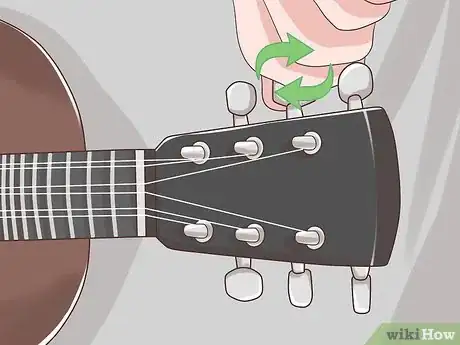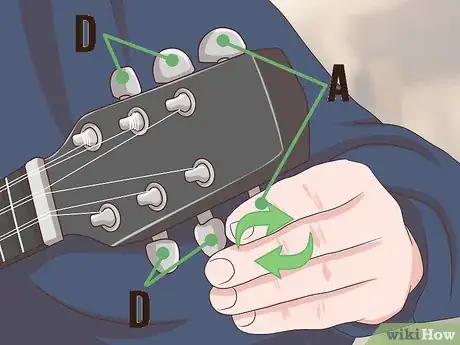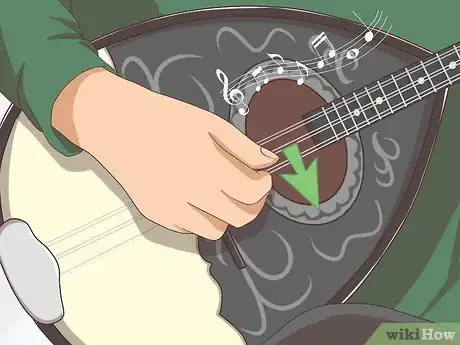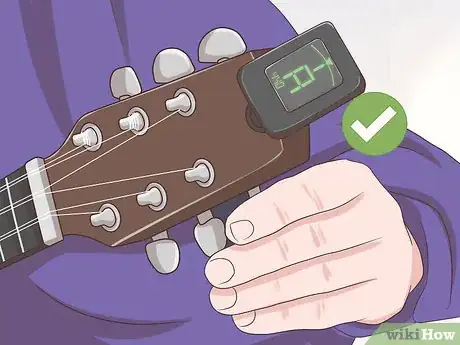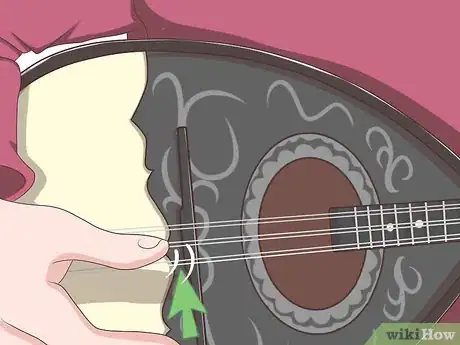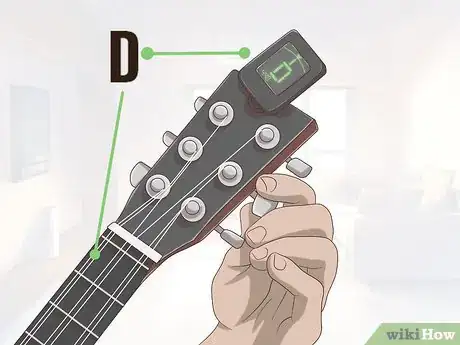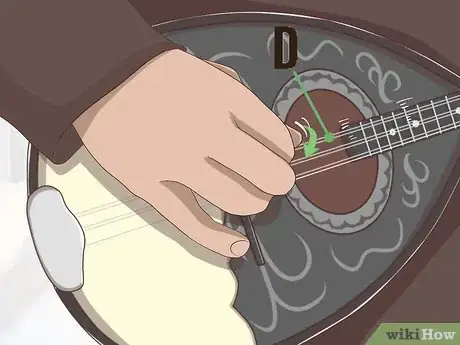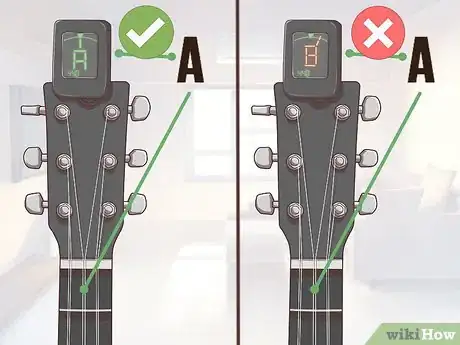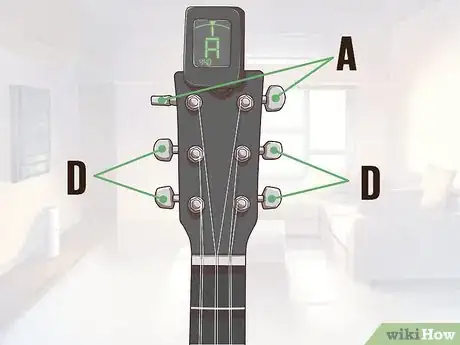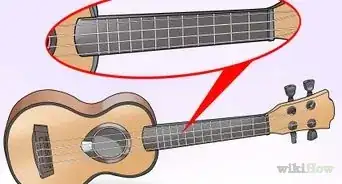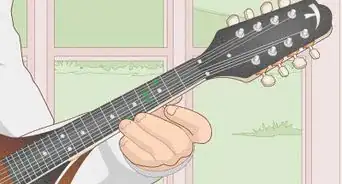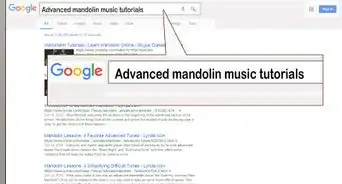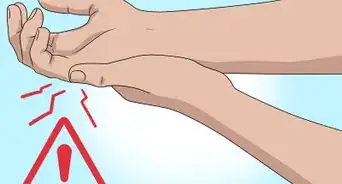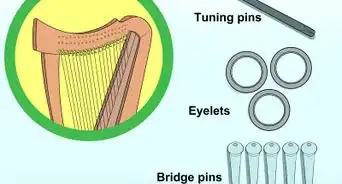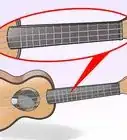This article was co-authored by wikiHow staff writer, Kyle Hall. Kyle Hall works on the content team at wikiHow. He helps manage our team of editors and creates content for a variety of wikiHow projects. Kyle continually looks for new ways to improve the content at wikiHow and make it more helpful and enjoyable for readers. He graduated from Eckerd College in 2015, where he majored in Political Science.
There are 10 references cited in this article, which can be found at the bottom of the page.
This article has been viewed 82,796 times.
Learn more...
The Greek bouzouki is a wooden string instrument that is commonly used in traditional Greek music. If you’re the fortunate owner of a bouzouki and you’ve realized your instrument is out of tune, don’t worry. There are a couple methods you can use to tune your instrument -- by ear or with a digital tuner -- so that you can get back to playing your favorite songs.
Steps
Understanding Your Bouzouki
-
1Check that your bouzouki is Greek and not Irish. Double check before you tune your instrument because Greek and Irish bouzoukis are generally tuned to different patterns. The easiest way to tell the difference between a Greek and Irish bouzouki is to look at their shape. A Greek bouzouki has a bowl-shaped back, while the back of an Irish bouzouki is flat.[1]
- You can also look at the scale length of your instrument to determine whether it’s a Greek or Irish bouzouki. A Greek bouzouki will have a longer scale, measuring around 680mm (about 27 inches), while an Irish bouzoukis scale length measures around 530mm (about 21 inches).[2]
-
2Count how many strings your bouzouki has. Traditional Greek bouzoukis have three string courses with two strings each, or a total of six strings. Other versions of the Greek bouzouki have four string courses with two strings each, or a total of eight strings.[3]Advertisement
-
3Match the tuning pegs to the strings on your six-string bouzouki. Each tuning peg is responsible for adjusting a different string on the instrument. Determine which tuning pegs adjust which strings before you begin tuning your instrument. With the front face of your bouzouki facing you, look at the tuning pegs:
- The two tuning pegs on the lower left side of your bouzouki will adjust the highest-pitched string course, while the two knobs on the lower right side will adjust the lowest-pitched string course. The two remaining top knobs on each side will adjust the middle-pitched string course.[4]
-
4Match the tuning pegs to the strings on your eight-string bouzouki. Tuning an eight-string bouzouki is slightly different than tuning a six-string bouzouki. With the front of your bouzouki facing you, look at the tuning pegs:
- The two tuning pegs on the lower right side of your bouzouki will adjust the lowest-pitched string course. The two pegs on the upper right side and the two pegs on the upper left side will adjust the middle-pitched string courses. The two pegs on the lower left side will adjust the lowest-pitched string course.[5]
-
5Determine what pattern you’ll tune your bouzouki to. Six-string bouzoukis are typically tuned to the pattern of D-A-D. Eight-string bouzoukis are typically tuned to the pattern of C-F-A-D.[6]
Tuning by Ear
-
1Tune one string at a time. You will need to tune each string separately to get your bouzouki back in tune. Hold the bouzouki as you would while playing it. Begin by tuning the string course located at the bottom of the instrument, which contains the highest-pitched strings.[7]
- After finishing your adjustments to the bottom course, move on to the next string course up the scale. Keep moving up, one course at a time, until you reach and tune the top course, which contains the lowest-pitched strings.
-
2Play the correct source note. Play it on a pitch pipe, piano, or other stringed instrument. Listen to the way the note sounds.
- The bottom course of your bouzouki should be tuned to the appropriate note above Middle C. For both six-string and eight-string bouzoukis, this would be the D just above Middle C (d' or D4).[8]
- Adjust the remaining courses according to the bottom course.
-
3Pluck one string in the course you’re tuning. Make sure the string isn’t pressed down on any fret along the scale of the instrument. The string should be able to vibrate without any interference. Listen to the way the note sounds in relation to the source note.
-
4Turn the corresponding tuning peg to adjust the string. Test the string after each adjustment until it matches the source note you played. If the tone sounds flat or too low, tighten the string by turning the tuning peg clockwise. If the tone sounds sharp or too high, loosen the string by twisting the tuning peg counterclockwise.[9]
- You may need to play the correct note several times on your pitch pipe or tuning instrument. Keep the sound in your mind for as long as possible and replay it each time you feel uncertain of how much further to adjust the course.
-
5Tune the other string in the course. The pair of strings in a course should be tuned in harmony with one another. Adjust the other string until it sounds the same as, or an octave of, the string you just tuned to match the source note. Strum them together to hear any differences and adjust if needed.[10]
-
6Check your tuning. After tuning all courses on your bouzouki, strum through the open strings again to check that everything is tuned properly. For the best results, also check each course separately. If every course sounds in tune, you’re finished tuning your bouzouki.
Tuning with a Digital Tuner
-
1Set your digital tuner's frequency. Most electronic tuners are already set to 440 Hz, but if yours is not set to a frequency yet, you will need to set it before you use it to tune your bouzouki. The display on your tuner should read something like: "440 Hz" or "A = 440."[11]
- Every tuner is adjusted differently. Read the instructions that came with your tuner to find out how to adjust its frequency. Typically, there is a "mode" or "frequency" button on the device that you can press.
- You should set the frequency on your tuner to 440 Hz. If your tuner prompts you to set the frequency by instrument, choose the “bouzouki” or "guitar" setting.
-
2Tune one course at a time. Each course needs to be tuned separately. Hold your bouzouki like you’re about to play it, and start by tuning the bottom string course, gradually working your way up.
-
3Set the note on your tuner each time you tune a course. Unless you have a "bouzouki" setting on your digital tuner, you will need to set the desired note on the digital tuner when tuning each course. Look for a “pitch” button or refer to your tuner’s instructions to change the note on your tuner.[12]
- The bottom course will need to be tuned to the corresponding note just above Middle C. For both six-string and eight-string bouzoukis, this would be the D above Middle C (d' or D4). Set your digital tuner to that note.
- The remaining courses should be adjusted according to the bottom course.
-
4Pluck a string in the course you’re tuning. Listen to the way the note sounds. Make sure you’re allowing the string to vibrate without any interference.
-
5Check your digital tuner to see if the string is in tune. Your digital tuner should have a monitor and indicator light that tells you whether a note you play is in tune.[13]
- The indicator light on your digital tuner should light up blue or green if the string you plucked is in tune. If the light turns red, that means the string is out of tune.
-
6Turn the corresponding tuning peg to adjust the string. If your digital tuner shows that the string you're working on is out of tune, adjust it using the matching tuning peg. Test the string after each adjustment by plucking it and referencing your digital tuner.
- Once you’ve successfully tuned the string, repeat the process to tune the other string in the course.
-
7Repeat the tuning process on each course of your bouzouki. After you tune the lowest course, set a new note on your digital tuner and adjust the next course up. Continue until all of the courses on your bouzouki have been tuned.
-
8Check your tuning. After you’ve tuned every course on your bouzouki, play the instrument a bit and pluck each course separately. Listen for any notes that sound off and make the necessary adjustments using your digital tuner.
Community Q&A
-
QuestionCan you tune a bouzouki to ukulele tuning? This bouzouki is a much smaller version than the full sized one, with 8 strings.
 Community AnswerNo, you cannot do this because it does not have the same 4 strings and same 4 notes.
Community AnswerNo, you cannot do this because it does not have the same 4 strings and same 4 notes.
Things You'll Need
- Greek bouzouki
- Pitch pipe
- Digital tuner
References
- ↑ https://www.youtube.com/watch?v=1M2wPNvME20
- ↑ http://www.mandolinluthier.com/tuning-bouzouki.htm
- ↑ http://www.greekfolkmusicanddance.com/instruments.php
- ↑ https://www.youtube.com/watch?v=bXzyMgtToeM
- ↑ https://www.youtube.com/watch?v=bXzyMgtToeM
- ↑ http://hspeek.home.xs4all.nl/bouzouki/stringing.html
- ↑ https://www.youtube.com/watch?v=bXzyMgtToeM
- ↑ http://www.pluck-n-play.com/en/tuning/bouzouki-tuning.html
- ↑ https://www.nde-ed.org/EducationResources/HighSchool/Sound/frequencypitch.htm








